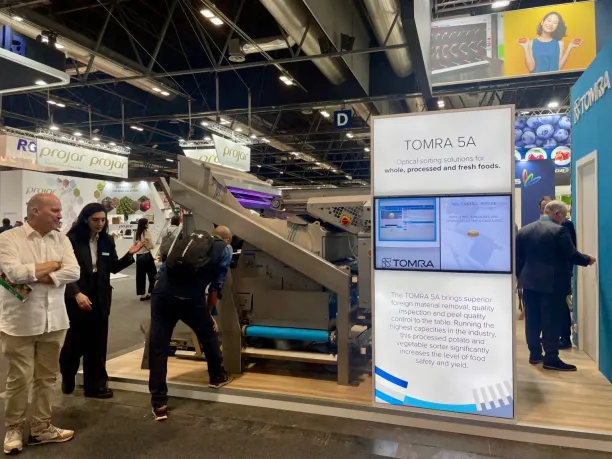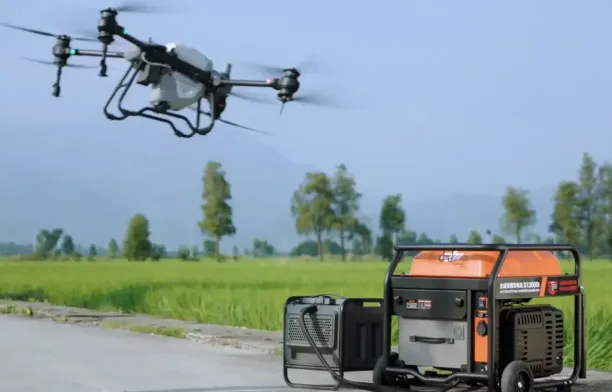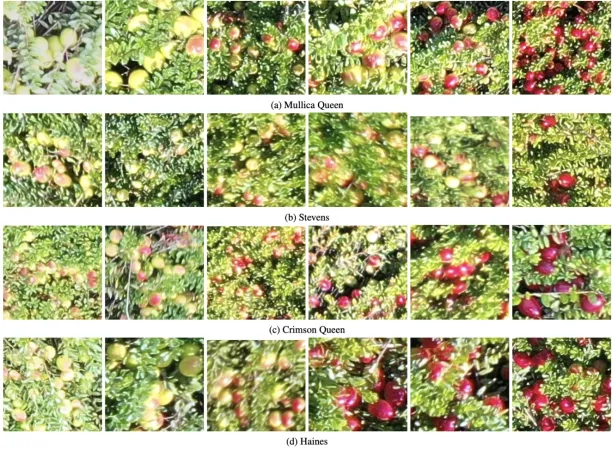The agriculture industry faces significant challenges, from climate change and labor shortages to supply chain disruptions. These issues put pressure on productivity and profitability.
Computer vision agriculture applications offer effective, technology-driven solutions. They help improve efficiency, reduce waste, and support better decision-making.
Explore the top 10 computer vision agriculture use cases helping the industry address current problems and drive future growth.
Computer vision agriculture use cases
| Use Case | Company | Summary |
|---|---|---|
| Crop monitoring with drones | Garuda Aerospace | Drones use computer vision to monitor crop health and soil conditions. |
| Crop sorting and grading | TOMRA Food | AI-powered machines sort produce by detecting defects and quality. |
| Pesticide spraying with drones | DJI | Agras T40 drone applies pesticides precisely using vision and AI. |
| Computer vision phenotyping | PhenoRob | Robots analyze plant traits for breeding and crop research. |
| Livestock farming | Connecterra | Ida platform tracks cow health and behavior via AI insights. |
| Weed detection and removal | FarmWise Labs | Titan FT-35 uses vision to remove weeds without chemicals. |
| Soil health assessment | SmartOne AI | Drones assess soil moisture, erosion, and nutrients with AI. |
| Aquaculture monitoring | Bosch Business Innovations | Vision tech monitors shrimp behavior to reduce feed waste. |
| Crop ripeness analysis | Research team | Vision models track ripening to optimize harvest timing. |
| Edge-AI for disease detection | Academic research | Mobile AI detects plant diseases offline in remote areas. |
1. Crop monitoring with drones
Drones equipped with cameras and sensors help monitor crops efficiently. Using computer vision techniques, these drones detect early signs of stress, pest attacks, and variations in soil moisture. They support image acquisition at scale, reducing the need for time-consuming manual labor.
In precision agriculture, drone-based crop monitoring enables farmers to assess crop health and growth and map field conditions.
Real-life example:
Garuda Aerospace, an Indian drone manufacturer, offers agricultural drones for crop monitoring.
Challenge and solution:
Farmers faced challenges manually monitoring large fields for crop health and soil conditions. By deploying Garuda’s drones equipped with computer vision technology, they could efficiently monitor vast farmlands, detect abnormalities, and make informed decisions.1
2. Crop sorting and grading
Sorting and grading harvested produce is a repetitive and time-intensive process. Through image analysis, computer vision models automate these tasks by detecting size, shape, color, and surface defects.
These agriculture computer vision systems can sort produce like potatoes or apples based on order requirements.
Real-life example:
TOMRA Food, a company specializing in sorting solutions, introduced AI-powered sorting machines like the TOMRA 5A (see the image below).
Challenge and solution:
Producers experienced inefficiencies in sorting large volumes of produce for quality control. By implementing TOMRA’s computer vision technology, they achieved high accuracy in detecting defects and foreign materials, enhancing product quality, and reducing waste.2

Figure 1: TOMRA 5A sorting machines.
3. Pesticide spraying with drones
Pesticide spraying can be hazardous and time-consuming. Drones with spray systems and computer vision applications identify affected areas and apply pesticides precisely.
These drones perform advanced image recognition and analysis to detect abnormal crop conditions and trigger spraying only where needed.
Real-life example:
DJI, a drone technology company, developed the Agras T40 drone for agricultural spraying.
Challenge and solution:
Farmers struggled with uneven pesticide application and labor-intensive processes. By utilizing the Agras T40’s computer vision and AI capabilities, they achieved uniform pesticide distribution, reduced chemical usage, and improved crop health.3

Figure 2: Agras T40 drone example for agricultural spraying.
4. Computer vision phenotyping
Phenotyping studies plant traits like shape, size, and color. Traditionally done by hand, it is now accelerated using artificial intelligence and computer vision tasks.
Cameras capture detailed images of plants, which deep learning models analyze to extract features and track growth stages.
Real-life example:
PhenoRob, a research initiative by the University of Bonn, focuses on robotics and phenotyping for sustainable crop production.
Challenge and solution:
Researchers needed efficient methods to analyze plant traits across large fields. By deploying computer vision and robotics, they could non-invasively monitor plant development, aiding in breeding and crop management decisions.4
5. Livestock farming
Computer vision in agriculture also applies to livestock management. High-definition cameras and deep learning algorithms monitor animals’ health, feeding behavior, and movement patterns.
These computer vision techniques detect abnormal behavior like limping or reduced activity.
Real-life example:
Connecterra, a Dutch company, developed the Intelligent Dairy Farmer’s Assistant (Ida) platform.
Challenge and solution:
Dairy farmers faced difficulties in continuously monitoring cow health and behavior. By using Ida’s AI-driven insights from sensor data, farmers could proactively address health issues, improving animal welfare and productivity.5
6. Weed detection and removal
Weeds lower crop yield by competing for water, nutrients, and sunlight. Traditional farming practices rely on manual weeding or herbicides. Both are time-consuming, and chemical use raises environmental and health concerns.
Using advanced image recognition and object detection, they distinguish between crops and weeds in real-time. Automated weeders equipped with these systems can mechanically remove weeds without harming nearby crops.
Real-life example:
FarmWise Labs, a U.S.-based agtech company, has developed the Titan FT-35, an automated mechanical weeder.
Challenge and solution:
Due to labor-intensive and chemical-reliant weed control methods, farmers needed a comprehensive solution to address these problems. By employing computer vision and robotics, the Titan FT-35 identifies and removes weeds without chemicals, enhancing efficiency and sustainability.6
7. Soil health assessment
Soil health is a key factor in determining crop productivity. Poor soil conditions affect root development and nutrient uptake. Traditional soil analysis involves sampling and lab testing, which delays decision-making.
Computer vision in agriculture enables real-time soil analysis using drone or satellite images. Image analysis models evaluate soil color, texture, and vegetation cover to assess moisture levels, erosion risk, and nutrient status.
Real-life example:
SmartOne AI offers tools that combine drone-based image acquisition and deep learning to evaluate soil health.
Challenge and solution:
Farmers who lacked timely insight into soil moisture or erosion patterns now use this solution to map fields and guide irrigation and fertilization. These computer vision applications improve resource utilization and support precision farming decisions.7
8. Aquaculture monitoring
Overfeeding and disease outbreaks can reduce yield and affect animal welfare in aquaculture. Manual monitoring of fish or shrimp behavior is often limited and lacks precision.
Computer vision systems analyze visual and audio data from underwater or surface-level cameras. They track animal movement, feeding patterns, and signs of disease, allowing for early detection and better control over farming conditions.
Real-life example:
Bosch Business Innovations applied artificial intelligence and computer vision techniques to shrimp farming.
Challenge and solution:
Farmers were struggling with feed wastage and late diagnosis of shrimp diseases. Bosch developed a system that uses visual data to analyze shrimp behavior and feeding habits. It helped reduce feed costs and improve survival rates.8
9. Crop ripeness analysis
Harvesting crops at the right time is critical for quality and market value. In traditional farming practices, ripeness is judged visually or by manual sampling, which can be inefficient and subjective.
Computer vision models can track color changes, shape, and texture to estimate ripeness levels. This helps in planning harvest schedules and reduces post-harvest losses. Integrating these models with drone-based monitoring provides a scalable approach.
Real-life example:
A research team developed a framework using vision foundation models for analyzing cranberry ripening stages.
Challenge and solution:
Cranberry growers needed accurate tools to determine harvest readiness across different varieties. The system identified crop maturity using drone imagery and ground-level cameras and helped optimize harvest timing.

Figure 3: Weekly drone imaging was used to inspect cranberry bogs from July to September for four varieties: Mullica Queen, Stevens, Crimson Queen, and Haines.9
10. Edge-AI for disease detection
Identifying plant diseases early can prevent large-scale crop loss. Farmers often lack access to labs or internet-based diagnostic tools in remote or low-resource farming areas.
Edge-AI brings computer vision to portable devices. Lightweight models can run on mobile hardware to analyze plant images and detect early signs of disease. This reduces dependency on cloud systems and enables offline decision-making.
Real-life example:
A recent study introduced an edge-AI approach using YOLOv8-S, a lightweight object detection model designed for use in areas with limited computational resources.
Challenge and solution:
Farmers could upload soil images or leaf photos, and the device would assess crop health and alert them to infections. This approach supported food security and reduced crop loss in under-resourced areas.10
Conclusion
Computer vision is essential in addressing the core challenges of modern agriculture. By enabling machines to interpret visual data, it supports critical tasks such as crop monitoring, sorting, pesticide spraying, and livestock management.
These computer vision applications help detect early signs of disease or stress, assess crop health, and reduce dependence on manual labor. The technology also contributes to precision farming by improving resource allocation and guiding timely actions based on real-time field conditions.
Computer vision models and image analysis improve efficiency and decision-making in use cases such as weed detection, soil analysis, aquaculture monitoring, ripeness estimation, and offline disease detection.
As agricultural productivity becomes more data-driven, implementing computer vision enables farmers to respond faster, reduce waste, and adapt to environmental variability.
External Links
- 1. https://www.garudaaerospace.com/agriculture/crop_management
- 2. TOMRA Food unveils new AI tech - Fruit Growers News.
- 3. DJI Agras T40: The Future of Agricultural Drone Spraying - HobiTech. HobiTech
- 4. PhenoRob - Robotics and Phenotyping for Sustainable Crop Production. PhenoRob
- 5. Connecterra - Intelligent data platform for the dairy industry..
- 6. Bot Verification.
- 7. The Top 10 Computer Vision Applications in Agriculture For 2024 | SmartOne.ai. SmartOne
- 8. How we can use AI to create a better society. Financial Times
- 9. https://arxiv.org/pdf/2412.09739
- 10. https://arxiv.org/pdf/2412.18635


Comments
Your email address will not be published. All fields are required.